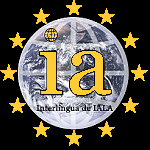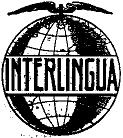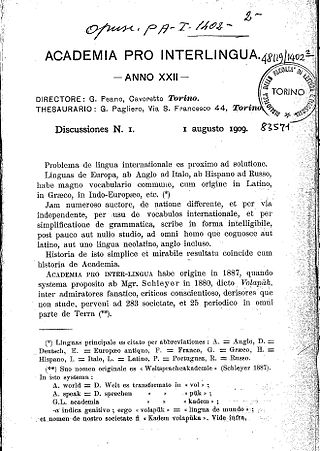
Giuseppe Peano was an Italian mathematician and glottologist. The author of over 200 books and papers, he was a founder of mathematical logic and set theory, to which he contributed much notation. The standard axiomatization of the natural numbers is named the Peano axioms in his honor. As part of this effort, he made key contributions to the modern rigorous and systematic treatment of the method of mathematical induction. He spent most of his career teaching mathematics at the University of Turin. He also wrote an international auxiliary language, Latino sine flexione, which is a simplified version of Classical Latin. Most of his books and papers are in Latino sine flexione, others are in Italian.

Interlingua is an international auxiliary language (IAL) developed between 1937 and 1951 by the American International Auxiliary Language Association (IALA). It ranks among the most widely used IALs and is the most widely used naturalistic IAL – in other words, those IALs whose vocabulary, grammar, and other characteristics are derived from natural languages, rather than being centrally planned. Interlingua literature maintains that (written) Interlingua is comprehensible to the hundreds of millions of people who speak Romance languages, though it is actively spoken by only a few hundred.

In neuropsychology, linguistics, and philosophy of language, a natural language or ordinary language is any language that has evolved naturally in humans through use and repetition without conscious planning or premeditation. Natural languages can take different forms, such as speech or signing. They are distinguished from constructed and formal languages such as those used to program computers or to study logic.

Interlingue, originally Occidental, is an international auxiliary language created in 1922 and renamed in 1949. Its creator, Edgar de Wahl, sought to achieve maximal grammatical regularity and natural character. The vocabulary is based on pre-existing words from various languages and a derivational system which uses recognized prefixes and suffixes.
An international auxiliary language is a language meant for communication between people from all different nations, who do not share a common first language. An auxiliary language is primarily a foreign language and often a constructed language. The concept is related to but separate from the idea of a lingua franca that people must use to communicate.

Latino sine flexione ("Latin without inflections"), Interlingua de Academia pro Interlingua (IL de ApI) or Peano's Interlingua (abbreviated as IL), is an international auxiliary language compiled by the Academia pro Interlingua under chairmanship of the Italian mathematician Giuseppe Peano (1858–1932) from 1887 until 1914. It is a simplified version of Latin, and retains its vocabulary. Interlingua-IL was published in the journal Revue de Mathématiques in an article of 1903 entitled De Latino Sine Flexione, Lingua Auxiliare Internationale (meaning On Latin Without Inflection, International Auxiliary Language), which explained the reason for its creation. The article argued that other auxiliary languages were unnecessary, since Latin was already established as the world's international language. The article was written in classical Latin, but it gradually dropped its inflections until there were none.
Idiom Neutral is an international auxiliary language, published in 1902 by the International Academy of the Universal Language under the leadership of Waldemar Rosenberger, a St. Petersburg engineer.

The Academia pro Interlingua was an organization dedicated to the promotion of international auxiliary languages, and is associated in particular with Prof. Giuseppe Peano's language Latino sine flexione.
Interlinguistics, as the science of planned languages, has existed for more than a century as a specific branch of linguistics for the study of various aspects of linguistic communication. Interlinguistics is a discipline formalized by Otto Jespersen in 1931 as the science of interlanguages, i.e. contact languages tailored for international communication. In more recent times, the object of study of interlinguistics was put into relation with language planning, the collection of strategies to deliberately influence the structure and function of a living language. In this framework, interlanguages become a subset of planned languages, i.e. extreme cases of language planning.
The International Auxiliary Language Association, Inc. (IALA) was an American organisation founded in 1924 to "promote widespread study, discussion and publicity of all questions involved in the establishment of an auxiliary language, together with research and experiment that may hasten such establishment in an intelligent manner and on stable foundations." Although it was created to determine which auxiliary language of a wide field of contenders was best suited for international communication, it eventually determined that none of them was up to the task and developed its own language, Interlingua.

Formulario Mathematico is a book by Giuseppe Peano which expresses fundamental theorems of mathematics in a symbolic language developed by Peano. The author was assisted by Giovanni Vailati, Mario Pieri, Alessandro Padoa, Giovanni Vacca, Vincenzo Vivanti, Gino Fano and Cesare Burali-Forti.
Ido and Interlingua are two constructed languages created in the 20th century, Ido circa 1910 and Interlingua circa 1940. Both have had some measure of success, but Interlingua has enjoyed greater diffusion and acceptance by public and private institutions—it is taught in many high schools and universities, for example. Ido was developed by a small committee from Reformed Esperanto, whereas Interlingua was developed from scratch by an American organization, the IALA.
The Interlingua–English Dictionary (IED), developed by the International Auxiliary Language Association (IALA) under the direction of Alexander Gode and published by Storm Publishers in 1951, is the first Interlingua dictionary. The IED includes about 27,000 words drawn from about 10,000 roots. It also presents 125 affixes that facilitate free word formation. Its full title is Interlingua: A Dictionary of the International Language.
Novial was created as an international auxiliary language by Danish linguist Otto Jespersen, who introduced it to the world in 1928. Jespersen had previously been a co-author of Ido, which started to take form around 1907. Both languages base their vocabularies primarily on prominent Germanic and Romance languages, but differ grammatically in several important respects. Novial is more analytic in its grammar than Ido, and, in Jespersen's view, more natural.

A constructed language is a language whose phonology, grammar, and vocabulary, instead of having developed naturally, are consciously devised for some purpose, which may include being devised for a work of fiction. A constructed language may also be referred to as an artificial, planned or invented language, or a fictional language. Planned languages are languages that have been purposefully designed; they are the result of deliberate, controlling intervention and are thus of a form of language planning.
The International Academy of Volapük was a ruling body established at the second Volapük congress in Munich in August 1887 with the goal of preserving and improving Volapük.

A pan-Romance language or Romance interlanguage is a codified linguistic variety which synthesizes the variation of the Romance languages and is representative of these as a whole. It can be seen as a standard language proposal for the whole language family but is generally considered a zonal constructed language because it's the result of intense codification. Zonal languages are, according to interlinguist Detlev Blanke, constructed languages which "arise by choosing or mixing linguistic elements in a language group".
Interlingue and Interlingua are constructed international auxiliary languages.








